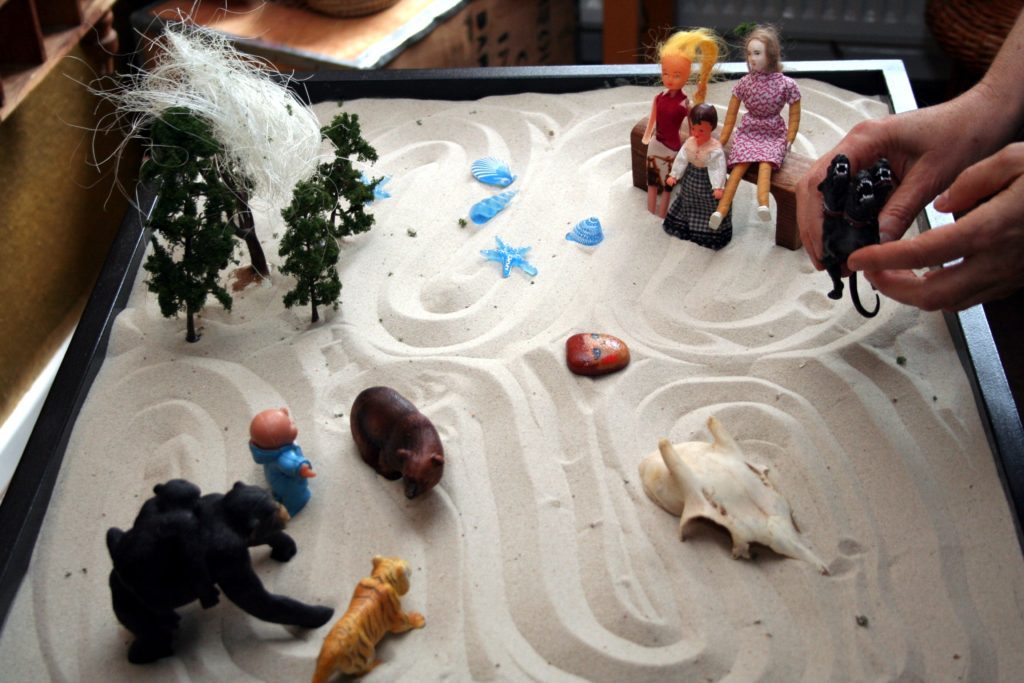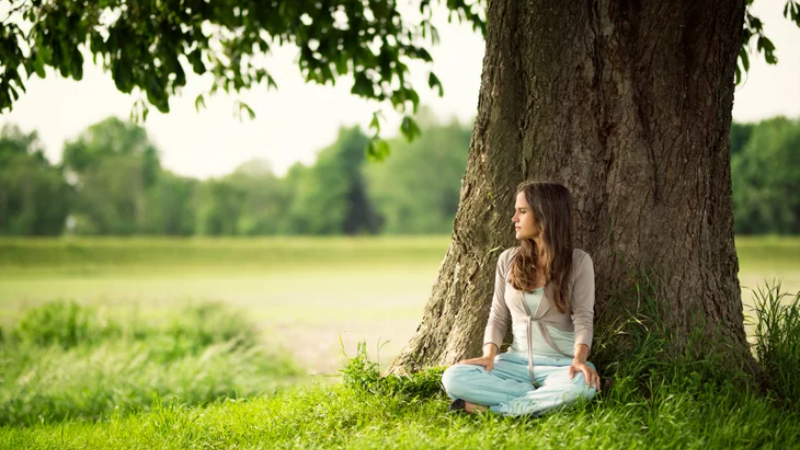Contact MEC | Help with Courses | My Account | Student Forum
Centering yourself is allowing yourself to get in touch with and be open to your True Self. It is allowing yourself to realize that you are perfect just as you are, even with your imperfections, because those feelings and desires are also a part of who you really are. If you accept your imperfections and integrate them into your way of thinking and feeling about yourself, you will obtain peace of mind, and you will be centered.

6.0 Finding Your Center
Creswell and Lindsay (2014) found that mindful centering helps people make less stressful assumptions and appraisals about life situations and helps to reduce stress reactivity responses. Dorais and Gutierrez (2021) found that a regular practice of centering meditation effectively reduces stress in college students. Centering meditations are an effective way to reduce stress and increase concentration, decision-making skills, and overall wellbeing.
Centering refers to the process of emptying your mind of any concerns about past problems or future worries. In Mindfulness-Based Ecotherapy centering is a way of preparing yourself for doing deeper meditative work. In simpler terms, centering is getting in touch with your True Self. In this session we will learn a few centering techniques. These centering skills lay the groundwork for connecting, which will be covered in Session 7.
Creswell, J. & Lindsay, Emily. (2014). How Does Mindfulness Training Affect Health? A Mindfulness Stress Buffering Account. Current Directions in Psychological Science. 23. 401-407. 10.1177/0963721414547415.
Dorais Stephanie, & Gutierrez, Daniel (2021). The Effectiveness of a Centering Meditation Intervention on College Stress and Mindfulness: A Randomized Controlled Trial, Frontiers in Psychology, Vol. 12, 2021.
6.1 Who are You?
Why are you, you? What are the things that make you the person that you are today? Why do inner work in the first place?
Many of us carry a vision of who we would like to be. We also carry a vision of who we perceive ourselves to be at this moment in time. The Humanist Psychologist Carl Rogers called these two visions the Ideal Self and the Perceived Self. At the times when we do not feel at peace with ourselves because of some anxiety, stress or depression, it is most often due to a conflict between our vision of who we would want to be, and who we perceive ourselves to be. In other words, we experience a conflict between the Ideal Self and the Perceived Self.
The act of centering involves striking a balance between the powers of chaos and order in our lives. From this perspective, the Ideal Self represents the power of order, and the Perceived Self represents the power of chaos. The way to strike a balance between these two powers is to introduce a little chaos into the order or introduce a little order to the chaos.
If conflict and inner turmoil are arising within you because of the gap between your Ideal Self and your Perceived Self, then the way to achieve balance would be to narrow that gap or to close it completely.
Suppose for example that your Ideal Self is a person who is organized, punctual and capable of completing multiple tasks at once during the day. On the other hand, your Perceived Self (the person you see yourself as) is not highly organized, always late, and incapable of meeting all the goals you set for yourself in a day.
The conflict within you has arisen in this case because you have set impossible standards for yourself, yet you feel you should be able to meet those standards anyway. One way to find balance in this situation would be to realize that your Ideal Self doesn’t have to be perfectly organized and punctual all the time, thereby allowing a little chaos to enter into the “perfect’” order established in your vision of your Ideal Self.
Another way to introduce balance is to impose a little more order upon the chaos of your Perceived Self by taking the time to plan better so that you are more able to meet the schedule set by your Ideal Self.
The goal of the inner journey that is Mindfulness-Based Ecotherapy is to strike a balance between the Ideal Self (or the life of perfect order) and the Perceived Self (or the life of perfect chaos). The more we learn about our own inner wants, needs and desires, and the reasons for them, the more we will draw closer to achieving balance. In short, if we can change our thoughts and feelings, we can change our world. But to change our thoughts and feelings, we must first know what those thoughts and feelings are.
There are many things we may wish to change about ourselves and about the world. We may even be able to change many of them. But there are also things that are beyond our power to change. Those things we cannot change, we must learn to accept. If we do not, then we will be endlessly frustrated by attempting the impossible.
According to a study by Dorais and Gutierrez (2021), Centering is a way to learn about your thoughts and feelings so that you may change them if you desire. This is most readily achieved through cultivating a spiritual sense of transcendence. We’ll be talking about how Mindfulness-Based Ecotherapy views spirituality in next week’s session, but for now let’s just say that the process involves getting in touch with and connecting to your own higher self. When that happens, you are centered.
Of course, it can be exceedingly difficult to tell which things we can change, and which things we cannot. This is where wisdom enters the picture. One purpose of centering is to gain enough inner wisdom to be able to know the difference between the things we can change, and the things we must accept.
Think for a moment about the last time you were anxious or stressed out. Do you remember what caused your anxiety? Did that cause of your worry have something to do with an event that happened in the past, or an event that might happen in the future? Until someone invents a time machine, there is no way to go back and change the past. Worrying about something that happened in the past is counterproductive. Likewise, if you are worrying about something that may or may not happen in the future, you are wasting energy that could be put to better use in the here and now. Unless you have a crystal ball, there’s no way of knowing for certain what may happen in the future. By worrying about it, you are expending energy that could be used to prevent the possible future disaster from happening in the first place.
When conflict arises within us due to conflicts between our Ideal Self and our Perceived Self, we can restore balance and eliminate or reduce that conflict by seeking wisdom through acceptance and change. If the conflict between our Ideal Self and our Perceived Self has to do with something that happened in the past or something that might happen in the future, then that is something we will have to learn to accept, since it is impossible to change the past, and it is impossible to predict the future with any degree of certainty. The only changes we may make involve things that are happening right now, in the present moment.
Remember, as you set out on the path of making changes in your life, that you cannot change anyone but yourself. If problems arise in your life because of the actions of another person, you cannot force that person to do anything. All you can do is to accept that they are who they are. Knowing this, you may then be able to change yourself so that you can accept others more easily. This acceptance can occur more readily if you learn to let go of the past and the future and focus only on the present moment.
Centering also means acknowledging that we can’t change anybody but ourselves. If we’re experiencing anxiety because of something in our relationships with another person or with other people, then we can’t change them. We can only change the way we interact with them. Centering allows us the wisdom to change ourselves in productive ways so that we can have more productive relationships.
Dorais, Stephanie & Gutierrez, Daniel. (2021). The Influence of Spiritual Transcendence on a Centering Meditation: A Growth Curve Analysis of Resilience. Religions. 12. 573. 10.3390/rel12080573.
Rogers, Carl (1980). A Way of Being, New York, NY: Houghton Mifflin.
6.2 Centering with Sandtray Expressive Arts
Centering at its most basic level is about bringing your awareness into the present moment by leaving doing mode and entering being mode. Centering from the perspective of Mindfulness-Based Ecotherapy is about connecting to that inner child, the internal observer known as your True Self.
The True Self exists in your mind’s conscious awareness of itself, but also in your mind’s unconscious self-expression. This means that in Mindfulness-Based Ecotherapy, centering means becoming aware of these unconscious manifestations of your True Self so that they may be brought into your conscious awareness.
So how do you become consciously aware of the unconscious? One way to do this is through Sandtray Expressive Arts (Degges-White, 2018, Garrett 2014).

In this form of therapy, the therapist or other facilitator has a sand tray in which the participant creates a scene based on a chosen topic. The facilitator usually has a vast collection of figurines, toys, statues, and other symbols in physical form that may be used to create the scene (Garrett 2015). The participant selects from these items to create a scene in the sandtray based on a pre-selected theme. In one type of sandtray therapy, called responsive sand tray, the person creating the scene is then asked to reflect upon and respond to the meaning created by the sandtray. Doing so can be a powerful means of centering.
If you are completing this workbook as a part of a Mindfulness-Based Ecotherapy program, your facilitator may have sandtrays with which to conduct this exercise. If you are completing this book on your own, you may choose to purchase your own sandtray. This can just be a plastic container big enough for the purpose, filled with play sand that may be purchased at any building supply store.
Alternately you can just do what I do when I conduct sandtray groups and just skip the sandtray altogether. In my programs we just create scenes directly on the ground.
The purpose of this sandtray exercise is to center by getting in touch with both the conscious and unconscious aspects of your True Self (Rogers et al 2020). In Mindfulness-Based Ecotherapy, “centering” means allowing your True Self to come forth and take control of your thoughts, feelings, and beliefs.
To practice centering with Sandtray Expressive Arts, first go to an outdoor place such as a park, a beach, a forest, or other natural area. If your own Sacred Space is suitable for the activity, it would be preferable to use it; but if you cannot, then use any natural area you have available.
Next, complete the exercise on the following pages.
Degges-White, Susan (2018). Integrating the Expressive Arts into Counseling Practice, Second Edition, New York, NY: Springer
Garrett, M. (2014). Beyond play therapy: using the sandtray as an expressive arts intervention in counselling adult clients. Asia Pacific Journal of Counselling and Psychotherapy, 2014 Vol. 5, No. 1, 99–105, http://dx.doi.org/10.1080/21507686.2013.864319
Garrett, M. (2015). 100+ Ideas for Directed Sandtrays in Counseling. Journal of Education and Human Development, March 2015, Vol. 4, No. 1, pp. 45-50
Luke, Melissa & Peters, Harvey. (2019). LGBTQ* Responsive Sand Tray: Creative Arts and Counseling. Journal of Counseling Sexology & Sexual Wellness: Research, Practice, and Education. 10.34296/01011002.
Rogers, Jennifer & Luke, Melissa & Darkis, Jessie. (2020). Meet Me in the Sand: Stories and Self-Expression in Sand Tray Work with Older Adults. Journal of Creativity in Mental Health. 16. 1-13. 10.1080/15401383.2020.1734513.
6.2 Centering with Sandtray Expressive Arts Worksheet
6.3 Centering Tree
Do you have a favorite tree? It could be a particular variety of tree, or just one tree near where you live. What about that tree attracts you? What can your affinity for that particular tree tell you about yourself? What characteristics do you share with your tree? How is your tree like you, and how is it different?
In other words, what sort of tree would you be if you were a tree?
Would you be an oak that firmly stands its ground when the winds of misfortune blow, or would you be a willow that remains rooted by bending and flowing with the storm? Would you be an apple tree that gives freely of its fruit of knowledge, or would you be a thorny mayhaw that makes the seeker fight for the harvest? Would you shed your leaves in winter and hibernate, or would you be green year-round, bringing life and energy to your leaf-shedding friends in their own cold winters?
In short, which tree are you?
For this centering tree exercise we will be identifying the characteristics of trees and comparing them to the characteristics of humans. We will be comparing the characteristics of your favorite tree to characteristics you possess in yourself. In this way we will be using trees as a metaphor to center ourselves. This act of centering occurs by comparing our own personal characteristics to the characteristics of a particular tree. Using nature as a metaphor for our own traits, we can learn more about ourselves, and therefore center ourselves.
The first step in this centering tree exercise is to identify a tree to work with. Do you have a tree that seems to call to you? Is there a type of tree that you identify with? If you’ve never thought about this before, spend some time thinking about it. It may help to walk through your neighborhood or your sacred space and see if any trees seem to call to you. Use the principle of natural attraction that you used to select your materials for the sandtray exercise.
Now that you’ve selected a tree, can you identify it if you saw one in the woods? If not, search online or use a field guide to learn to identify your tree. If you have a park or forest nearby, try to find your tree somewhere outdoors. It should be a location where you may meditate undisturbed for at least ten minutes. If you don’t have access to your own tree, you may do the meditation outdoors under any tree available. If you don’t have access to any trees, or if the weather isn’t conducive to outdoor meditation, you may also do the meditation indoors. Picture yourself sitting under your tree as you do the meditation. Remember, we’re reaching into the power of the unconscious mind, and activating our own personal tree archetypes during this meditation. The goal is to center by connecting with your own True Self. We will use the characteristics of your chosen tree as a metaphor for your own True Self, so when you connect with your tree, you will be connecting with a metaphor of yourself.
When you have found your tree and you’re ready, go on to the next section and perform the Tree of Life Meditation. If possible, do the meditation under your chosen tree. If it’s not possible to sit under your tree while performing the meditation, then visualize your tree while meditating.

6.4 Tree of Life Meditation
Begin this meditation by finding a comfortable place, preferably outdoors. If you have identified your centering tree, and such a tree is nearby, sit comfortably underneath it (weather permitting, of course), with your back resting against the tree. If you must do this meditation indoors, sit comfortably in a quiet area where you may be undisturbed for the duration of the meditation.
You may read the directions below step-by-step as you perform the meditation. Alternately you may wish to record yourself reading the steps out loud, then play back the recording as you perform the meditation. If you have a trusted friend with a calming voice, you might also ask them to guide you through the meditation by reading the points below.
- Before beginning this meditation, center yourself by emptying your mind of all distractions.
- Start with a few cleansing breaths.
- Begin the Tree of Life meditation by thinking of a color that gives you peace and serenity. This should be a color that brings you happiness, joy, and relaxation.
- Now visualize a small sphere of light in this color, radiating from your solar plexus, just above your navel.
- Picture this light flowing downward, out of the tip of your spine, into the earth below you. See it branching off like the roots of a tree, drawing strength and energy from the earth. With each breath, you are drawing more energy out of the earth.
- Your spine is becoming the trunk of a tree: The Tree of Life. Feel the energy rising from the ground to become part of your being. This is called ‘grounding,’ and is the beginning of any meditation.
- Feel the energy rise through the trunk of your spine into the crown of your head. See the energy as colored light, bursting forth from the top of your head.
- The light energy emerging from your head is branching off in all directions, reaching out to touch the heavens above with each exhaled breath.
- Watch the energy rise far above you, like the branches and leaves of the Tree of Life.
- How far does your energy reach? Can you reach the stars? See the light energy flowing within you, uniting the realms of earth and sky. Feel yourself becoming a part of all that is. You are merging with the life force of all existence.
When you feel you have reached Unity with the Tree of Life, meditate on these questions:
- How am I like all that exists?
- How am I different?
- How can I be more at peace with all that is?
- What teachings do my senses give to me?
- What teachings do my dreams give to me?
- How closely do my dreams match my reality?
- Can I bring my reality into closer harmony with my dreams? How?
- To close this meditation, note any insights you have gained.
- Now see the roots and branches of energy slowly returning to the center of your being. The energy of the life force is not leaving you; it is simply concentrating itself into the center of your being.
- When you have returned to this world, open your eyes, and take with you the lessons you have learned today from the Tree of Life.
Guided Tree of Life Meditation
The video below contains a guided Tree of Life Meditation for grounding and centering. Try it at least once yourself. You may also use it with your students when you create your own Mindfulness-Based Ecotherapy program.
After completing the Tree of Life meditation, go on to the exercise on the next page, Reflections on the Tree of Life Meditation.
6.4 Reflections on the Tree of Life Meditation Worksheet
6.5 Getting to Know Your Tree
To begin exploring the wealth of knowledge to be gained from trees and other plants, start by selecting a tree to spend some time with. This tree can be your centering tree or any tree that you feel drawn to. It should also be a tree that it would be convenient for you to visit at least once a week. This should be a tree with which you have a strong relationship. If you have not yet developed a relationship with a tree, go out into the woods, preferably in the spring of the year, and select one that seems to call to you.
Spend some time cultivating a relationship with that tree. Sit under its branches in the shade while meditating. Study its leaves, its branches, its roots, and its bark. Research folklore associated with your tree. Are there any medicinal uses for your tree? Does your tree have any practical uses? What might you make out of its wood? What might you use its leaves, bark, roots and fruit for? How is your tree like you? How is it different? What strengths does your tree have, that you might find lacking in yourself? What strengths do you possess that your tree does not? What can you learn about yourself from studying your tree?
As you learn about your tree, don’t forget to bring it gifts from time to time. Talk to your tree and listen for a reply. Don’t expect answers in words; listen with your heart and spirit. Spend the time learning from your tree and befriending it. Watch how it changes from season to season. Know its moods and its habits. Know its needs and its gifts. Become an expert on your tree.
At first it may seem odd to think of trees as having moods, but as you come to know your tree, it may not seem so odd at all. As you spend time with your tree, learning its moods will become almost second nature to you.
To begin understanding how to learn a tree’s feelings, think about how you observe the feelings of your friends and family. A subtle change of posture, or a slight change of facial expression, and you can tell when your romantic partner is feeling a bit down. Likewise, the more you know your tree, the more you will become sensitive to its moods.
Explore your tree with your senses. Taste its fruit. Smell its blossoms. Touch its bark. Does its scent change with the seasons? Does its bark feel different in the morning than it does in the evening? Can you tell by taste when the fruit is ripe for the picking? The more time you spend with your tree, the more you will become attuned to how these changes manifest.
When you truly come to know your tree, you will see that it can predict the weather by the way its leaves orient themselves. You will be able to know when your tree is about to bear fruit, when its leaves will begin to shed, and when the seasons are about to change. When you begin to understand the ways of your tree, you can take energy from your tree when you need it, and you can give energy to your tree when it needs you.
Optional Activity: A Year with Your Tree
Because this activity takes an entire year, it is usually outside of the scope of the 12-week Mindfulness-Based Ecotherapy seminars, so you may wish to do this on your own.
Once you have found your centering tree, you may wish to develop a deeper relationship with it. The best way to do this is to befriend your tree for at least a year. By doing so you will have observed your tree in all seasons. You will have experienced all its manifestations throughout the year.
If you choose to do this, you may wish to keep a Centering Tree Journal. You may write any of your observations about your centering tree in this journal. You may also use it to record any lore, songs, or poetry about your tree. If your tree bears leaves, you might press them and place them in your journal, one for each season.
You may also take photographs of your tree from time to time and watch as it grows.
Notice that from time to time, trees shed their leaves. Branches fall off. New growths of leaves or flowers or fruit begin. Trees are ever-changing. They are a reminder that we are always changing and growing too. Just because on occasion our own leaves fall off and our own branches may need an occasional pruning, that doesn’t mean that new growth won’t come in the spring.
As you and your tree change together, it can help you to find your own roots, your own branches, and your own center.
6.6 The Tree at the Center
How old are you? How long have you lived? What does age mean, really? In the beginning, the Universe was nothing but hydrogen. Then came the first stars, which exploded and made the elements. These elements congealed into planets, and eventually into animals, then humans. The body you inhabit now is made of star dust. The atoms in your body witnessed the explosion of the Big Bang. The elements of which you are made are billions of years old. You are as old as the stars. You have been here since the beginning of the Universe.
Your body is about 70% water. Some of your body’s water was once dew on the first grasses that grew on the Earth. A dinosaur once drank the water that is now contained within you. Some of the water that makes up your body once flowed past the Sphinx in the Nile River. It once quenched a lion’s thirst in the deserts of Africa. Your water has been mammal, fish, and fowl. It has known what it is like to be an insect, and a king. It has been a tiny raindrop and a mighty ocean.
The atoms that make up your body once slept at the heart of a star. Some of your atoms have been reptiles and amphibians. Others have been great eagles or majestic beasts. Still other atoms have dwelt within the trees of the forest before becoming you. The collection of atoms called ‘you’ is as old as the Universe.
Visualize your life as a timeline. Each choice you make on that line redefines who you are. With each choice, you create two paths: One path in which you made the choice and one path in which you didn’t make the choice. All our choices along the line of our lives branch out behind us like the twigs of a tree. Each node where a choice was made is a node where fruit can grow, or where fruit can wither and die.
Picture the line of your life as the trunk of a tree. This is the tree at the center of your life. As you look at the tree that is your life, note that its roots disappear into the ground, out of sight. These roots have branches too. These branches are the choices you made in the past that brought you to this life, here and now. In your mind’s eye, follow those roots. See how they intertwine with the roots of other trees in the forest. Can you tell where your tree ends and where another begins?
Now follow the branches of the tree that is you. Note how they mingle with the other branches of the forest. Can you tell where your branches end and other trees begin? How many trees are there, really? Could it be that they are all one? Is one tree really separate from another, or are we all part of the same Tree at the Center?
If we are all connected to everything and everyone around us, how can we ever be separate? From this perspective, learning is just the process of rediscovering what we already know. We already have the knowledge within us; we simply have to remember how to access it. Let nature be your guide, and then you will remember how to learn what you already know, deep within yourself.
6.7 Lessons from the Tree of Life
As you spend more time with your tree, you may come to find that as you learn about it, you learn about yourself. Trees are centered and grounded. The more time you spend with your tree, the more you will find yourself grounded and centered as well.
In the Tree of Life meditation, you pictured your energy descending, root-like, deeply into the earth. As you progress through the lessons of Mindfulness-Based Ecotherapy you may likewise find your attention and consciousness becoming more and more rooted in the soil of your True Self. This centering in your true identity is the ultimate lesson from the Tree of Life. When you have learned it, you will always be able to find your center.

Contact MEC | Help with Courses | My Account | Student Forum

